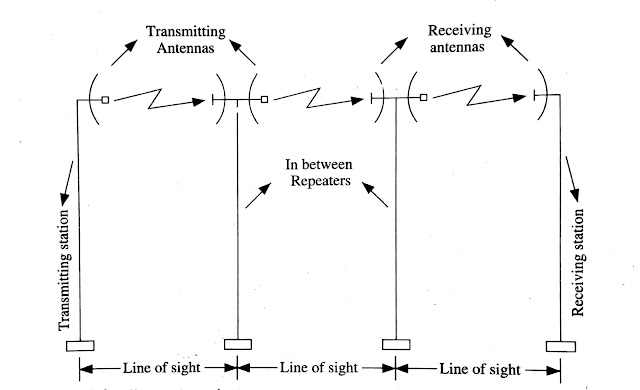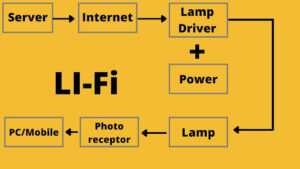Microwave
Transmission
Microwave
transmission is a powerful method of communication that was widely used in
long-distance telephone transmission systems before the invention of optical fibre
cables. Concentrating all the energy into a small beam using a parabolic
antenna (like a Dish Antenna) gives a much higher signal-to-noise ratio, but
the transmitting and the receiving antennas should be rightly aligned with each
other. Before the invention of optical fibre cables, these microwaves formed
the heart of long-distance telephone transmission systems. There were lots of
problems in the microwave transmission process like line-of-sight etc. so we
should use repeaters at intervals of about 25 to 30 KM in between the
transmitting and receiving antennas.
The illustration shows microwave communication from
one point to another.
Above 100
MHz, waves travel in straight lines and can be narrowly focused using a parabolic
antenna, such as a dish antenna, to achieve a much higher signal-to-noise
ratio. However, it’s crucial that the transmitting and receiving antennas are
aligned correctly. Despite its benefits, microwave transmission can encounter
challenges, such as line-of-sight issues, which can be addressed by using
repeaters at intervals of around 25 to 30 km between the transmitting and
receiving antennas. The use of repeaters can ensure that the signal is
amplified and transmitted reliably. The illustration accompanying this
paragraph shows microwave communication from one point to another, illustrating
the focused beam used in microwave transmission. Overall, microwave
transmission remains a vital method of communication, especially in areas where
optical fibre cables are not feasible.
Microwaves, unlike radio waves, do not pass through
buildings well at lower frequencies. But there is still some divergence in
space. Some waves may be reflected off low-lying atmospheric layers and take
slightly longer to arrive than direct waves. The waves that are delayed, may
arrive out of phase with the direct wave and thus cancel the signal. This
effect is called Multipath Fading. In microwave communication systems, sometimes it
causes a serious problem.
The first repeater is placed in the line of sight of the transmitting
station while the last repeater is placed in the line of view of the receiving
station. There are two consecutive repeaters placed in the line of sight of
each other. Each of these stations receives the signals, amplify them and then
transmits them on its way. Since microwaves travel in a straight line, the
earth’s curvature will get in the way if the towers are too far apart.
Consequently, repeaters are needed periodically. If the towers will high then
they can transmit the signal much further. The distance between repeaters will
vary with the square root of the tower height. If the height of the tower is
100 meters, then repeaters can be spaced 80 km apart.






Nice article, which you have shared here. Your article is very informative and I liked your way to express your views in this post. Thanks for sharing this article here. Ferrule Connector.
Thank you very much sir